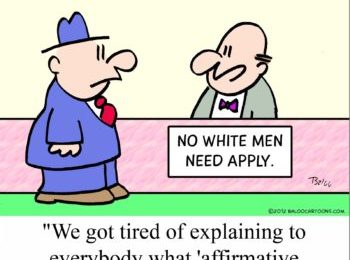 The following discussion about the reality of race was posted previously on The Official Website of Representative David Duke but it fits in well with our current series of articles and the facts that it presents bear repeating. Understanding the reality of race is fundamental to our continued survival. –Dave Cooper
The following discussion about the reality of race was posted previously on The Official Website of Representative David Duke but it fits in well with our current series of articles and the facts that it presents bear repeating. Understanding the reality of race is fundamental to our continued survival. –Dave Cooper
The following was a statement released by Professor Phillippe Rushton of the University of Western Ontario in response to attempts to discredit the very concept of race and to argue that race “has no validity as a biological concept when applied to man.”
STATEMENT ON RACE AS A BIOLOGICAL CONCEPT
J. Philippe Rushton
November 4, 1996
Discussion of “race” shows little sign of diminishing, despite efforts to deconstruct the concept. Deconstructing the concept of race not only conflicts with people’s tendency to classify and build family histories according to common descent but also ignores the work of biologists studying non-human species. Ever since 1758, when the Swedish naturalist Carolus Linnaeus created the classification system still used in biology today, most zoologists have recognized at least the four human subdivisions Linnaeus delineated: Asians, American Indians, Europeans, and Africans. (Technically, some would group the first two Linnaean subdivisions together, thus yielding three major races, often termed, mongoloids, caucasoids, and negroids.) Such high-level classifications do not rule out making finer, hierarchical subdivisions within these major groups.
A race is what zoologists term a variety or subdivision of a species. Each race (or variety) is characterized by a more or less distinct combination of inherited morphological, behavioral, physiological traits. In flowers, insects, and non-human mammals, zoologists consistently and routinely study the process of racial differentiation. Formation of a new race takes place when, over several generations, individuals in one group reproduce more frequently among themselves than they do with individuals in other groups. This process is most apparent when the individuals live in diverse geographic areas and therefore evolve unique, recognizable adaptations (such as skin color) that are advantageous in their specific environments. But differentiation also occurs under less extreme circumstances. Zoologists and evolutionists refer to such differentiated populations as races. (Within the formal taxonomic nomenclature of biology, races are termed subspecies). Zoologists have identified two or more races (subspecies) in most mammalian species.
Unless one is a religious fundamentalist and believes that man was created in the image and likeness of God, it is foolish to believe that human beings are exempt from biological classification and the laws of evolution that apply to all other life forms. Of course, individuals vary greatly within each racial group and should be treated as such. Nonetheless, much has been learned by studying the statistical differences between the various human races. In my book Race, Evolution, and Behavior (1995, Transaction Publishers), as well as in other recent writings (e.g., the February 1996 issue of Current Anthropology), I review the behavioral, morphological, and physiological differences between the three major human races — mongoloid, caucasoid, and negroid — and show that these statistical differences are constant across both historical time, national boundaries, and political and economic systems.
Here I will briefly summarize the findings. Asians and Africans consistently aggregate at opposite ends, with Europeans intermediate, on a continuum that includes over 60 anatomical and social variables. These 60 variables include brain size, intelligence, sexual habits, fertility, personality, temperament, speed of maturation, and longevity. If race were an arbitrary, socially-constructed concept, devoid of all biological meaning, such consistent relationships would not exist.
Those objecting to the concept of race argue that the taxonomic definitions are arbitrary and subjective. Although critics are correct to point out that the variation within each race is extremely large, that there is disagreement as to exactly how many races there are, and that there is a blurring of category edges because of admixture, they are in error when they claim that classifications are arbitrary. For example, race-critic Jared Diamond, in the 1994 issue of Discover magazine, surveyed half a dozen geographically variable traits and formed very different races depending on which traits he picked. Classifying people using anti-malarial genes, lactose tolerance, fingerprint patterns, or skin color resulted in the Swedes of Europe being placed in the same category as the Xhosa and Fulani of Africa, the Ainu of Japan, and the Italians of Europe.
Jared Diamond’s classifications, however, are arbitrary and nonsensical because they have little, if any, predictive value beyond the initial classification. More significantly, they confuse the scientific meaning of race, that is, a recognizable (or distinguishable) geographic population. In everyday life, as in evolutionary biology, a “negroid” is someone whose ancestors were born in sub-Saharan Africa, and likewise for a “caucasoid” and a “mongoloid.” This definition fits with the temporal bounds offered by the best current theory of human evolution. Thus, since Homo sapiens first appeared in Africa about 200,000 years ago, branched off into Europe about 110,000 years ago, and into Asia 70,000 years after that, a “negroid” is someone whose ancestors, between 4,000 and (to accommodate recent migrations) 20 generations ago, were born in sub-Saharan Africa — and likewise, for a caucasoid and a mongoloid.
Social definitions — that is, self-identification and other-identification actually accord quite well with the physical evidence. Mongoloids, caucasoids, and negroids can be distinguished on the basis of obvious differences in skeletal morphology, hair and facial features, as well by blood groups and DNA fingerprints. Forensic anthropologists regularly classify skeletons of decomposed bodies by race. For example, narrow nasal passages and a short distance between eye sockets identify a caucasoid person, distinct cheekbones characterize a mongoloid person, and nasal openings shaped like an upside down heart typify a negroid person. In certain criminal investigations, the race of a perpetrator can be identified from blood, semen, and hair samples. To deny the predictive validity of race at this level is nonscientific and unrealistic.
The mean pattern of educational and economic achievement within multi-racial countries such as Canada and the United States has increasingly been found to prove valid internationally. For example, it is not often recognized, perhaps because it contradicts the politically correct theories that intelligence is purely a matter of socio-economic conditions, that Asian-Americans and Asians in Asia often outscore white Americans and white Europeans on IQ tests and on tests of educational achievement (even though the tests were largely developed by Europeans and white Americans for use in a Euro-American culture). Blacks in the Caribbean, Britain, Canada and sub-Saharan Africa as well as in the United States have low IQ scores relative to whites. For violent crime, analyses of INTERPOL data from the 1980s and 1990s show the same international distribution that occurs within the United States (that is, Asians least, Europeans in the middle, and Africans most). A similar racial gradient is found both within the U.S. and globally for measures of sexual activity and frequencies of sexually transmitted diseases such as AIDS (based on World Health Organization data).
One neurohormonal contributor to crime and reproductive behavior is testosterone. Studies show that black college students and military veterans have 3% to 19% more testosterone than their white counterparts. The Japanese have even lower amounts than whites. Sex hormones are circulated throughout the body and are known to activate many brain-behavior systems involving aggression and reproduction. For example, around the world the rate of dizygotic twinning per 1,000 births (caused by a double ovulation), is less than 4 among Asians, 8 among Europeans, and 16 or greater among Africans. The differences in multiple birthing are known to be heritable through the race of the mother regardless of the race of the father, as found in Asian/European matings in Hawaii and European/African matings in Brazil.
Publication of The Bell Curve brought widespread public attention to the research on race that has been accumulating over the last 30 years in technical and specialist journals that demonstrably challenges each and every article of the dogma of biological egalitarianism. Startling, and alarming to many, is the conclusion that follows from these data that if all people were treated the same, most average race differences would not disappear. With egalitarianism under siege, there has been a major effort to get the “race genie” back in the bottle, to squeeze the previously tabooed toothpaste back into the tube, to suppress or deny the latest scientific evidence on race, genetics, and behavior.
Regardless of the extent to which the media promote “politically correct,” but scientifically wrong, resolutions from professional societies such as the American Anthropological Association, facts remain facts and require appropriate scientific, not political, explanation. On average, the Chinese, Koreans, and Japanese are more similar to each other and are different from Australians, Israelis and the Swedes, who in turn are similar to each other and are different from Nigerians, Kenyans, and Jamaicans. None of this should be construed as meaning that environmental factors play no part individual development. But with each passing year and each new study, the evidence for the genetic contribution to individual and group differences becomes more firmly established than ever.
ABOUT THE AUTHOR
J. Philippe Rushton is a John Simon Guggenheim Fellow and a professor of psychology at the University of Western Ontario in London, Ontario N6A 5C2 Canada. He holds two doctorates from the University of London (PhD and DSc) and is a Fellow of the American Association for the Advancement of Science and of the American, British, and Canadian Psychological Associations. His latest book Race, Evolution, and Behavior (1995, Transaction Publishers, telephone 908-445-2280) details the theories and data summarized in this article.



